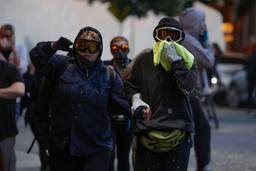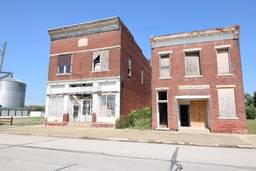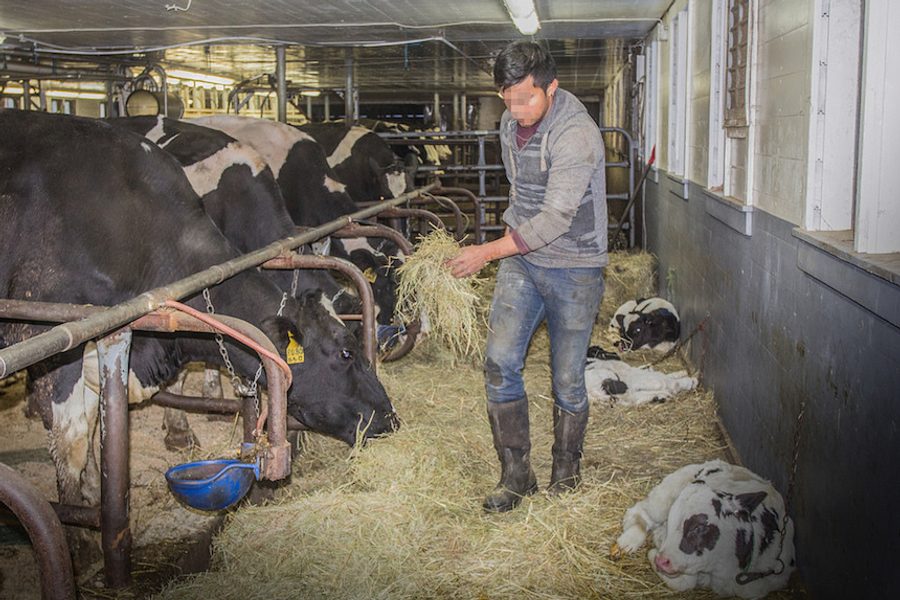
“Hey, come on in,” I told Carlos. Silhouetted by summer sun, he stood at the front door of my Vermont house.
“No,” he said pointing to his work boots, heavy with mud and manure. “But can you help me?” Carlos was one of the estimated one to 2,000 undocumented, mostly Mexican migrants employed on the state’s dairy farms. The actual number, like most of the workers who entered the country illegally, is hidden.
Carlos (not his real name) had come to Vermont after a year working construction in Texas, where even gringo bosses speak some Spanish, and where he could blend into the large Latino diaspora and its familiar culture. Vermont is an alien world, with dark winters and light people. When the dairy workers venture off their isolated farms, they stand out and apart. But in an unparceable blend of Yankee pragmatism and ordinary decency, many Vermonters, including police and officials, quietly welcome and often protect them. The farm hands form an essential part of the economy, and truth be told, offer relief from a monotonously white population that tends tolerant and leans smug.
I met Carlos several years back when, as part of an informal volunteer network, I’d occasionally ferry migrants to medical appointments or to supermarkets, where they buy the kind of calorie-rich junk and processed food that horrifies kale-munching locals. I helped fill out forms enabling them to wire money to family in Mexico, lending my name and return address, and wondering what the IRS would make of my sending thousands of dollars to small towns in Tabasco and Chiapas.
After Vermont approved a special driver’s license not requiring legal status, I taught a few guys to drive by U.S. rules so they could shop for themselves, get a maple creemee at a roadside stand, and visit relatives and friends on other farms.
Several migrants had given me snippets of their tales — always without embellishment, self-pity, or drama. But it was years before Carlos — bright and charming, but guarded — opened up. Perhaps fording the flooded Rio Grande and hiking five days through the Texas desert — helicopters thumping the sky; hunger, thirst, and border patrols stalking the ground below — seemed so common as to be unremarkable, or too painful to recall.
Through Carlos has learned useful and colorfully idiomatic English, he speaks hesitantly, especially with strangers, and misunderstandings are possible. The favor he came to ask that sun-painted day was that I go with him for a “check-up.” “Well,” he hesitated, “to get tested for STI” (sexually transmitted infections). “Are you sick? Do you need to go immediately?” I asked. “No, I’m fine. I just want to get tested. Soon.”
The community clinic I phoned required two appointments, one for paperwork and another for testing. Two days interrupted, during haying season.
Make hay while the sun shines is a literal injunction. Three or four times a summer, when the grass is high and tightly tasseled, machines prowl the fields devouring the sweet green crop. It dries in place for three or so sunny days until balers bundle the now-golden hay, and workers load it into barns for winter feed.
Sometimes at midnight, if the weather threatens, headlights flicker through my window as a neighboring farmer rushes to save the crop before it is ruined by rain.
So when the grass is ripe and there is a predicted stretch of sunshine, haying cannot be delayed.
To save time, then, Carlos suggested going to a “doc in a box” in a strip mall. At the generic office, which looked like it could be selling insurance, which Carlos could never buy, I asked the cost. “$100 for the visit.” As he started taking bills from his wallet, I motioned him to stop. “And for the lab tests?” The young woman rummaged behind the counter. “$500, so $600 total,” she said with all the animation of one of Carlos’s cows.
“You’re kidding,” I nearly shouted. “For standard lab tests?”
“No way,” I told Carlos, who was probably deeply embarrassed by me. It wasn’t that he couldn’t afford it, but I knew how he sweated for that much money, and how the medical system jacked-up prices for the uninsured.
I phoned the health clinic to compare costs, and the scheduler asked why didn’t I go to Planned Parenthood. It had never occurred to me that the organization served men.
Except for a locked front door, security at the controversial nonprofit was unobtrusive. Joining three pregnant women in the waiting room, Carlos and I made quite the intriguing couple: an aging white woman and a handsome young Latino.
When we came to the part of the form on income, Carlos asked me what to do. I said he could report whatever amount he wanted. No, he corrected, do they want hourly, weekly, or what? He knew what I had meant, but had no inclination to cheat. He wrote $30,000 a year.
The receptionist quickly scanned his paperwork. “We have a sliding scale,” and with obvious pleasure, told Carlos, “You just qualify for free services.”
Vermont, she said is the only state fully covered by the Access Plan which includes birth control, annual exams, STI testing and treatment, patient education and counseling for both men and women who are uninsured and earn less than 200 percent of the federal poverty level.
It is a practical policy, given the long-term economic and public health benefits of diagnosing, treating, and preventing the spread of communicable diseases that can lead to AIDS, cancer, sterility, and more.
How else are males served? By way of reply, the receptionist reached under the counter. “We distribute these,” she said, handing me a football-sized clear plastic bag filled with condoms, individually wrapped in colorful foil decorated with hearts and flags, kissy lips, and stars.
When Carlos returned from the exam room, he was assured, although a few tests were pending, that he was clean. I tossed him the bag, and we all laughed. As we left, I spied him slipping a donation, three $20 bills, onto the counter.
In the car home, curiosity overcame discretion. I probed. He hesitated. And then his face lit with pleasure. “I have a girlfriend, and she said, ‘No sex until we are both tested.’”
“Now, that is a great girlfriend,” I said. Smiling, we rode back under a cloudless sky to his farm, where the ripe fields glittered green and the cows, udders swollen, jostled in line for afternoon milking.
Milk, money and the role of migrants
The presence of foreign-born migrant workers like Carlos is just the latest transformation of Vermont agriculture. A century ago, the state was 70 percent cleared agricultural land, 30 percent forest. Today, the ratio is approximately reversed. Older Vermonters still remember when, in the 1940s, some 11,000 small, family farms the dotted the land. Kids hand-milked fawn-brown, doe-eyed Jerseys before breakfast and then hitched rides to one-room schoolhouses on the beat-up trucks or horse-drawn wagons that hauled metal jugs of milk — topped with unctuous, yellow cream — to central collecting stations.
The number of farms continues to decline — from 1,030 to 825 just in the last decade. Strained by the high costs farming, taxes, and land prices, many have been drawn over, like an artist’s repurposed canvas, by malls, ski resorts, and summer homes. The last time Vermont had more cows than people Eisenhower was president; today there are 625,000 people and only 129,000 cows.
Nonetheless, milk production is up. Jerseys have been replaced by black and white Holsteins, a large, ungainly breed that can churn out massive quantities of milk — 20,000-plus pounds a year — before their productivity wanes and they are ground into hamburger, pet food, or buried in the fields they once fertilized and grazed.
Along with the switch to Holsteins, federal and state tax abatements and subsidy programs, the increased cache and cash for the Vermont-branded and organic products, larger scale production, mechanization, and a new generation of back-to-the-land growers have allowed some farmers to survive, and a few to thrive.
What keeps the owners awake at night — besides the callous vagaries of weather and fluctuating milk prices that sometimes fall below costs — is finding and keeping cheap labor. Most have tried locals, and some have turned to former prisoners. But few stick it out, and farmers grumble that the growing plague of opioid dependence has rendered some of the Americans duller and less reliable than the cows they tend.
It is little wonder that Americans with other options do not last. There are few jobs as miserable as trudging through frozen piss and excrement in the pre-dawn dark to milk and tend cows when the thermometer plunges to 20 below zero. With two milkings a day, 12 hours apart, farms must be staffed 14 to16 hours a day. Despite the myth of the manger, cows don’t get Christmas off, and neither do dairy workers.
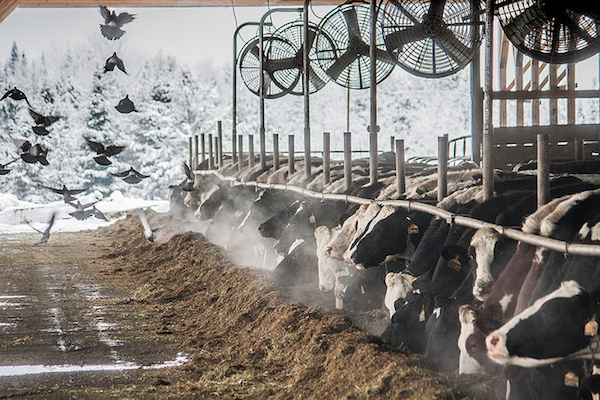
A Vermont dairy farm in winter. (Photo: Terry J. Allen)
Latino migrants are filling a gap and saving America’s farms. Nationwide, immigrants, many undocumented, comprise 51 percent of the nation’s dairy industry, according to a 2015 study by Texas A&M University for the National Milk Producers Federation. If these workers were deported, the report concludes, milk prices would rise 90 percent, and cost the U.S. economy more than $32 billion.
Without “our guests,” as then Vermont Gov. Peter Shumlin called migrant farm workers, much of the state’s milk industry would likely dry up and bring down a cascade of dependent, value-added enterprises. Say goodbye to affordable Cabot cheddar; kiss Vermont-sourced Cherry Garcia sweet adios.
And farewell to much of the $2.2 billion in annual economic activity dairy brings Vermont — the only state in which more than half of farm income comes from a single commodity.
But beyond its direct economic contribution, dairy farming defines Vermont’s landscape, culture, image, values, and allure. It contours land and life, lures tourists, and helps retain residents through seven leafless months. Farms open the pastures — golden and green in summer, glistening white like polished steel in winter. River-riven valleys and soft hillsides speckled with black and white cows embody Vermont’s old-fashioned beauty: its working landscape.
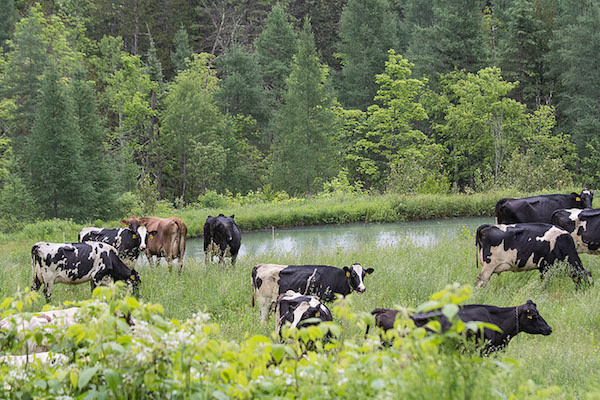
Vermont’s iconic Holstein cows. (Photo: Terry J. Allen)
Isolation, ICE and Snow
Immune to the idyll, Carlos was simply seeking a job. “It’s hard, hard work,” he says. “But you came to America to make money and go back quick. So you come to Vermont.”
At his previous job— construction for a large company in a mid-sized Texas city — the hourly wages were comparable to dairy, but the potential earnings and the cost of living were not. The Vermont jobs include housing with heat and other utilities, isolation that brings fewer spending temptations, and an “opportunity” to work up to 90 hours a week.
Although he expected the long, difficult hours, Carlos never anticipated winter’s malice. “I still remember asking my brother, who came a few months before I did, ‘How is Vermont?’ and he said, ‘Don’t come here. It’s horrible.’ He came in winter,” Carlos adds, grinning. “But I came anyway… in a van with my cousin and some others. I saw snow for the first time. I was, ‘What is this?’ he chuckles. ‘What am I doing here?’”
At this layover farm, “they taught me to milk cows,” and now he lets out a loud laugh at the absurdity, “in one afternoon.”
“The next day Auntie Linda arrived. She speaks Spanish, and all the patrons know her. They all call her and say ‘We need one guy, two guys.’ She was a grumpy old woman, a big curser. We laughed at her swearing, but we didn’t care. I’d like to talk to her today and thank her. She gave me a pair of boots. They went through the whole winter.”
Brokers like Auntie Linda, the “coyotes” who smuggle migrants across the border, the people who run safe houses, the van drivers who make regular interstate and cross-country runs, and the farmers are all moving parts of a complex, subterranean machine powered by cell phones and dollars.
One small, but particularly venal piece of that network is the sex traffickers. Almost all of the dairy workers are young men stuck on rural farms with no transportation to get to town or engage in normal social life. Enter the pimps who, exploiting the loneliness and isolation of the workers, import women from cities and drive them to remote farms to “service” the workers at $60 a trick.
“They just bring girls, Mexicans and Colombians, mostly Latinas, but sometimes [women] from here, too,” Carlos explains reluctantly. “They just show up. It could be months between visits, or could be the next weekend. You never know. They never came to our farm, and I know one thing, I’m not paying for that.” I push for more information. “They say it’s expensive, good, and they like it.” And then with exasperation and embarrassment, “Jesus, why are you asking me about this?”
A prostitution ring in Vermont came to light in 2011, when police arrested two men who brought women to have sex with workers for $60 a trick. Alejandro Enrique Young-Hernandez who organized the business, was convicted of conspiracy to transport individuals for prostitution. Although the crime could carry a 10-year sentence, he received 2-years’ probation, $100 court fee, and loss of his right to own firearms. His fellow pimp, Jose Tomas Flores-Rocha, who delivered the women to the farms, was convicted of a lesser charge, transporting individuals for prostitution, but served 18 months.
Between his arrest and sentencing, I ran into Young-Hernandez at another cog in the migrant machine. A few times a year, officials from the Mexican consulate in Boston travel to areas with numerous unauthorized Mexican citizens and, after careful screening, provide legal identification papers. The document allows migrants to buy a plane ticket to return to home, to prevent their being mistaken for criminals if picked up by authorities; and, in Vermont and 11 other states plus DC, to obtain a restricted “driving privilege” license. A group of Vermont volunteers helps facilitate the consulate event, organizing car pools and providing medical and legal resources and a communal meal.
Whispers fluttered like moths when Young-Hernandez, conspicuous with neck tattoos and flashy clothes, swaggered around the room, cornering workers for hushed conversations.
While the Mexican IDs are useful, they do nothing to change U.S. legal status. And impediments to obtaining lawful visas are nearly insurmountable. Most non-professional immigrants who qualify for a green card (permanent residence status) gain it through a family relationship to a U.S. citizen. Temporary H-2A agricultural visas last for months and only for strictly seasonal jobs like planting and picking crops. One Vermont produce farm sponsored the same Jamaican brothers for H-2As every spring for almost three decades, until both farmer and workers grew too decrepit to carry on.
The state’s Congressional delegation has tried but, even before Trump made Mexican migration a third-rail issue, failed to legislate an exception for year-round dairy crews.
So with no legal options, and the workers’ importance to the economy, most of Vermont turns a blind eye, even a welcoming hand. That extends to “sanctuary” towns and a Fair and Impartial Policing policy that enjoins police from profiling and targeting “illegals” or checking status when not specifically relevant. It’s “human rights 101,” Montpelier Police Chief Anthony Facos told the local Times Argus newspaper.
In 2015, a Grand Isle sheriff arrested Miguel Alcudia, a Mexican national, whose only crime was illegal entry, and turned him over to the Border Patrol. Activists, including other unauthorized farm workers poured on political pressure. Vermont Congressmembers Patrick Leahy, Bernie Sanders, and Peter Welch and Gov. Shumlin supported Alcudia’s case. A few months later, he was freed and the Sheriff’s Department fined nearly $30,000 for its discriminatory action.
No similar outcome is likely for Enrique Balcazar, Zully Palacios and Alex Carrillo. Recently Immigration and Customs Enforcement (ICE) agents targeted and detained the three prominent activists with Migrant Justice, a Burlington, VT-based group advocating for dairy workers’ rights. Public demonstrations and a sharp letter from the state’s Congressional delegation and Republican governor denounced the detentions.
Support for the migrants is not universal among Vermonters. Some workers at the Department of Motor Vehicles contacted authorities to drop the dime on people with “South of the Border” names who applied for the special driver’s licenses, according to emails obtained through a public records request by Migrant Justice. One email gloated: “I’ve emailed the docs to Border Patrol and they will research further and get back to me. They sound pretty excited. I let them know [applicant] has re-scheduled for this Friday. I will also contact [DMV employee] and let him know what is going on, should he have to play stupid.” Another email warned, “We are being over run by immigrants.”
Incidents like that, the targeted detentions, and hyperbolic threats from the Trump administration have sent waves of worry through farmers and workers alike.
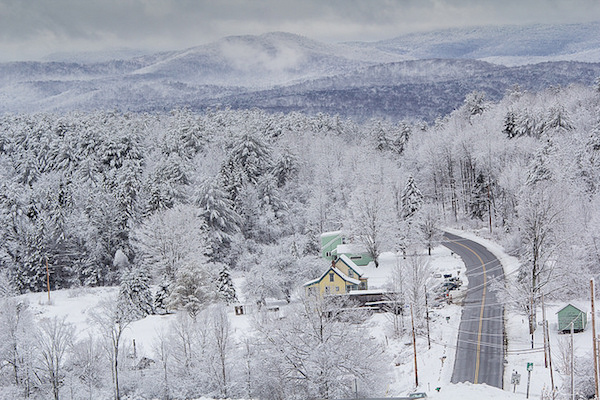
A Vermont snowscape. (Photo: Terry J. Allen)
Low wages, high taxes and tiny lingerie
“Are you afraid of immigration authorities?” I asked Carlos on the trip back from Planned Parenthood. “I used to think about it every day,” he said, “but now it doesn’t matter if they send me back, because that’s where I belong. I always tell my parents, I’m coming back this December, and they get a piglet to raise for a big party. And then I stay yet another year.”
It is not only money, and perhaps a girlfriend, that link Carlos to Vermont, but also the farm itself. People who raise horses, the saying goes, love the animals; sheepherders love the landscape; dairy farmers love the machinery. Self-reliant and smart, Carlos has made himself valuable by learning to handle the farm’s large stock of trucks, manure spreaders, balers, tedders, and other machinery. “I work sometimes 70, often 80 hours a week, sometimes 90. “Never, never 60 hours a week,” Carlos notes with pride. Farm labor — legal and not — is specifically excluded from U.S. overtime pay regulations.
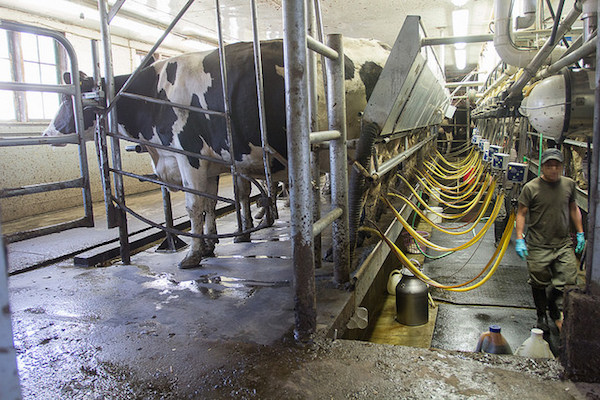
“Milking parlors” use cups, hoses and vacuum tubes, all of which require routine cleaning and maintenance. (Photo: Terry J. Allen)
Although his wages rose to $11.30 an hour plus a $150 monthly bonus when milk quality tests high, he clears only about $9 hour. The difference is taxes.
When they arrive at a farm, the migrants provide Social Security numbers. “They are all fake,” says Carlos, matter-of-factly. “Somebody just gives you one. ”
To stay legal, farmers withhold and file taxes — the benefits of which the worker can never collect in social security or unemployment benefits.
On the campaign trail, Donald Trump called CNN’s Erin Burnett “naïve” for suggesting “illegal immigrants” pay taxes. But nationally, they contribute an estimated $11.64 billion a year in just state and local taxes, with at least 50 percent of undocumented immigrant households filing tax returns, according to the non-partisan Institute on Taxation and Economic Policy.
Vermont’s undocumented pay almost $4 million a year in state and local taxes and, at 7.9 percent of income, contribute slightly more than the effective rate for the top 1 percent.
One of the few advantages of lacking an agricultural visa — which is tied to a specific employer — is that unauthorized farm workers can switch farms, relying on a grapevine to avoid abusive bosses. Carlos says that his patron, a tough taskmaster and a hard worker himself, “was always fair.” Their relationship, however, started badly. “When I got here, I didn’t know English and it was rough for me, and for him, I think. He would try to tell us what to do [in English] and he would get mad if something was not done how he wanted. It was always our fault. I couldn’t explain myself. I think that’s what got me to learn English.”
Over time, the two men grew reliant on and genuinely fond of each other. “Now I know a little English and I can tell him what’s wrong. And he always jokes that, ‘I don’t know if I liked you better when you didn’t know any English.’ So like, yup, this is what it is. And he always pays us on time.”
That is not the case on all farms. Because of their status, undocumented workers are vulnerable to exploitation. “Some farmers never pay more than $7.50 an hour,” says Carlos. “I know a guy that the boss didn’t pay him, just fired him when he asked for money. But Migrant Justice went, and the farmer had to pay.”
That local activist group and others have also intervened to address farm workers’ living conditions. Some share a room in the boss’s house, some live in poorly insulated and dilapidated trailers or crammed into filthy bunkhouses. The worst-off sleep in the barn. “I know a farm where they almost sleep with the cows,” says Carlos. “They have a little room off the milking parlor and just a door to divide them from the cows. I was at a farm like that the other day and I was like, “Where’s your house?’ ‘This is where we live,’ he said, and I was like ‘What?’ I didn’t ask how many people lived in the room.”
Carlos and the other workers at his farm have their own rustic, but comfortable, house with TV and wifi, cable, a stove, and refrigerator.
It is these ”free” accommodations, heat, and other utilities, along with long hours, that facilitate the real goal: putting money aside for a better future for themselves and family back home. Despite one “really dumb” purchase of “that no-good Mustang” (He is, after all, a 22-year-old male), Carlos has been able to save and send back enough to buy land, “not much, build my house, buy 10 cows,” and help out his older siblings and parents.
Out-of-pocket expenses, if the workers are lucky, are pared down to the food they cook for themselves, phone service, and clothing. I’d drive guys to their store of choice, Walmart, where they bought up jeans made in Mexico that they said cost less than they would have back home. Once, I took a worker who was returning the next day to Mexico to the “fancy store,” J.C. Penny, to buy presents to bring his wife. The saleswoman stalked us nervously as we examined filmy lingerie and nearly intervened when the worker held a red and black lace bra up to a mannequin to gage size.
Crossing the Desert of the Dead
A week or so after the Planned Parenthood visit, Carlos and I had lunch and I asked, promising anonymity, if he would talk to me — as a journalist — about his experiences. He started reluctantly. He was 16, he said, just out of high school with a bit of technical school when he took the two-day bus ride from Tabasco to Reynosa, a bitter, hardscrabble border city, deep in poverty, guns, gangs, and drug violence.
There, he and his two-year-older brother met the man who might lead them safely to a job in America, into the hands of border agents, or to death in the desert. These coyotes ply the ragged edge of capitalism. Some are professional “guides” simply doing an illegal and dangerous job for which they expect high pay; some are con men bent on exploitation.
“If you come to the border alone, you will always find a coyote,” Carlos told me, “but you never know if it is someone who is reliable or will just take your money.”
One way to mitigate the risk of rip-offs and scams is by making arrangements ahead. Five years before, “my father made it to the states and knew which coyotes to trust,” said Carlos. In Reynosa, “someone would phone us and tell us the color of the car or truck, red or green, that would take care of us. But we never ever communicated with the coyote himself in any way until the moment we were on the border and we met in a bus station parking lot.”
“My coyote was one of the better ones,” Carlos said. “But all of them. It’s just about the money.”
And even the better ones cannot guarantee a successful crossing — even before Trump whipped up anti-migrant fervor and enforcement zeal.
“It’s a risk we all take,” said Carlos, “and you never know how it will end.”
In 2011, the year Carlos crossed the river, the Border Patrol apprehended 327,577 people in the U.S.-Mexican border region. Almost 16,000, like Carlos, were “unaccompanied alien children,” under 17 years old. The agency “rescued” more than 1,000 and documented 375 deaths.
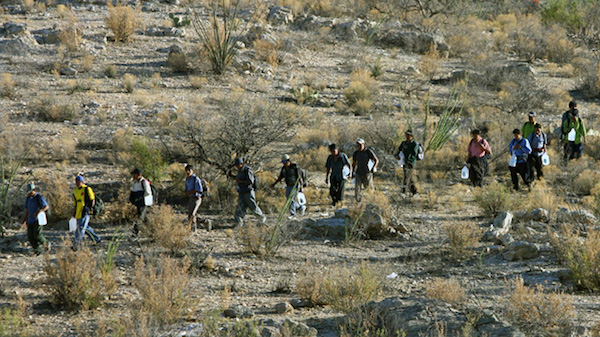
According to the U.S. Border Patrol, 1,954 people died crossing the U.S – Mexico border between the years 1998 and 2004. Most humanitarian organizations estimate the number is much higher. (Photo: elpais.cr)
The ones who made it safely joined America’s 11 million unauthorized immigrants, who, in 2014 accounted for around 5 percent of U.S. civilian labor force, the Pew Research Center estimates. Six million Mexicans, about half that total, are mostly concentrated in farming (26 percent) and construction occupations (15 percent).
Some migrants who make the crossing, especially those from Honduras and Guatemala, are escaping gang wars and may be eligible for refugee status. But almost all Mexicans are economic migrants seeking to better their lives.
“My papa, he grows watermelon and corn,” Carlos tells me, “and was the first to come to America. And when he was here, we always had something to eat. I came five years after [he returned]. “Now I am always helping them. I send money. My sister and brother [who are also in America illegally] can’t so much, because they have families to support, but I don’t.” Carlos is the youngest of five siblings. “My family [in Mexico] is doing fine and if they need something, they let us know, and we will get it for them. They never suffer for lack of food, gracias a dios.”
It was agreed, then: Carlos would pay his coyote $500 before they left Reynosa and arrange for someone to deliver $1,500 once he reached a safe house in Texas, far enough from the border that he could move on or blend in.
“They always need that money punctually, or it is dangerous. They can do anything to you.” I saw the fear that threat engendered in the face of another migrant who pleaded with me to rush him to a Western Union counter to wire money to release his friend or relative from a stash house in Arizona and be loaded onto a van packed with migrants and pointed east.
In Reynosa, the coyote took Carlos and his brother to a series of houses. “When they are ready to cross the river, they gave me a life vest, and we start to walk. It had been raining a lot, so the river was very high. It was during the day, because in the night, there were others crossing.”
The coyote led them to an inflatable boat and asked who knew how to swim. “I told them I didn’t, and that’s what you are supposed to say so they don’t throw you in the river.” The Rio Grande was swollen far into the trees on the U.S. side, and the dozen travelers, including three or four women, plus the coyote, had to leave the boat, which couldn’t navigate through the trees, and walk through chest-high water.”
Carlos brought water “aspirin and lemons, in case we run out of water.” The coyote gave them food to carry. “The meals, like beans, were all cans. And a lot of bread, tortillas.”
Once on dry land, with the twack of helicopters “always, always,” beating the sky above, they walked rapidly, seeking cover while trying to evade sensors in the ground, cameras, and law enforcement patrols. After several more hours, the group reached a road where “we met a little truck. And we drove through a normal neighborhood … to a house where there were about 30 women, men, and children, not only Mexicans, but also Columbians and Hondurans.”
“They gave us food and a place to sleep. And some clothes and shoes, because ours were wet. You just take whatever fits you.” The next day, they boarded a truck that dropped them in the desert. Spackled with scrub and dry grasses, dotted with mesquite trees, livestock, rattlesnakes, and a rare ranch house, the dry land stretched beyond the horizon.
The Border Patrol calls the area the Rio Grande or McAllen Region. Spanish explorers had a more descriptive name: El Desierto de los Muertos, the Desert of the Dead.
Carlos became quiet, reached for a glass of water and stared at the table. Then, as if a switch had flipped, he began talking rapidly.
“I walked for five days,” he said, and when he saw me wince, added with annoyance at my pity, “That’s nothing compared to people I know; 15 days, 16 days in the desert, a month. That’s why people die, or they go with the wrong coyote, and then someone gets tired, they just leave them there.
“I saw a woman who was exhausted, and she was in our group. The coyote said ‘It’s her or all of us.’ She was in her 30s. He didn’t really want to leave her where no one would find her, so we went to a place where he thought the Border Patrol might pass. He gave her a bottle of water and left her there. She said nothing, didn’t even cry.
“Hours after we left her, we started to hear footsteps like someone is behind us and thought it was immigration. It was her. I can’t explain it, how she did it. She was almost about to die when we left her. Somehow she came.
“After three days, we ran out of water. I remember that was horrible, and then food was getting scarce. I was doing fine, but my brother, he was the one who was very exhausted, and a friend of mine, too. But we continue and continue. And the coyote, he always says, ‘We just have to get to that light.’ He tries to give us hope. ‘Are you ready to make dollars?’”
“We were just exhausted. I remember I got dizzy a little and felt like we are walking in the same way all the time.
“And then we waited at the side of the road. Waiting and waiting and helicopters are always flying. And it was terrifying. Then a truck shows up and quick, we all ran into it.” I have never seen Carlos talk so freely, so long.
“For hours, we couldn’t move. And that was horrible in the truck, all packed together. And all like this, like this.” He draws himself into a tight knot. “I still remember a child, maybe he was 14, crying. He says he just wants a little bit of water, but they can’t stop. ‘No, you are almost there. Almost there.’
“And then we got to a house, and there is a guy at a table, and he is phoning people, saying, ‘Hey we got your son, your daughter.’ My dad sent someone with money to pick us up. And that friend took us to an apartment.”
Eventually through a network, Carlos found the construction job and stayed in Texas for a year, until he decided Vermont was worth a try.
“So I have been here five years,” Carlos says. “I never thought I would stay that long, but I got used to it. I like Vermont. The people are really nice, but,” he grinned, “the winter, not so much.”
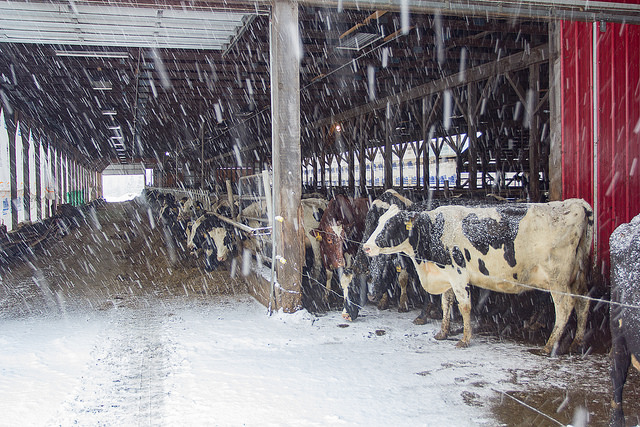
Winter on a dairy farm. (Photo: Terry J. Allen)
This story was based on conversations in Spanish and English, and one interview aided by a bilingual interpreter. Some names have been changed, and quotes have been edited for clarity.
A shorter version of this article—“My Undocumented Friend: Carlos Does the Work Few in Vermont Want To Do”—was printed in The Guardian.

